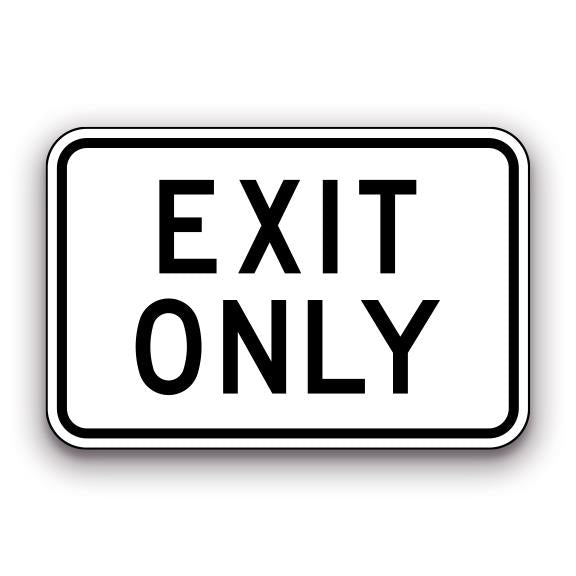Traffic signs are crucial for ensuring road safety and smooth traffic flow. They provide clear instructions to drivers and reduce confusion, helping everyone reach their destination safely. Among these, the Exit Only Do Not Enter Sign plays a vital role in preventing accidents and directing vehicles correctly.
What Is an Exit Only Do Not Enter Sign?
The Exit Only Do Not Enter Sign is a specific traffic sign designed to guide drivers and prevent wrong-way driving. It is typically rectangular or square, with bold lettering and contrasting colors—usually red and white. The words “Exit Only” and “Do Not Enter” are prominently displayed to grab attention. Some versions include additional symbols, such as arrows, to clarify the intended direction.
This sign is placed strategically where vehicles are not allowed to enter, such as highway exits, private driveways, or restricted areas. Its primary purpose is to control traffic flow and ensure safety by keeping vehicles from entering areas where they may cause collisions or disruptions.
The Importance of Following Exit Only Do Not Enter Signs
Adhering to the Exit Only Do Not Enter Sign is critical for both safety and efficiency on the road.
- Safety Implications: These signs help prevent serious accidents, such as head-on collisions or wrong-way driving, which can result in severe injuries or fatalities.
- Traffic Efficiency: By guiding vehicles into the correct lanes or exits, these signs ensure smoother traffic movement and reduce congestion.
- Legal Consequences: Ignoring these signs can lead to fines or penalties, as violating traffic regulations is a serious offense. Additionally, it may increase your risk of liability in accidents caused by such violations.
Drivers who respect these signs contribute to safer roads and better driving experiences for everyone.
Common Locations for Exit Only Do Not Enter Signs
The Exit Only Do Not Enter Sign is often found in high-traffic areas where clear direction is essential. Common locations include:
- Highways and Freeway Exits: These signs prevent vehicles from entering ramps in the wrong direction, reducing the risk of high-speed collisions.
- Parking Lots and Multi-Story Garages: They help drivers avoid restricted exit-only pathways and maintain orderly traffic flow in busy parking areas.
- Private Properties or Restricted Zones: Many businesses or residential complexes use these signs to restrict access to areas meant only for specific vehicles, such as delivery trucks or authorized personnel.
- Supplementary Signs: In some areas, you may see Keep Left Signs alongside Exit Only Do Not Enter Signs to further clarify traffic rules. These signs provide additional direction for drivers to follow the correct lanes or pathways.
How Exit Only Do Not Enter Signs Differ from Other Warning Signs
While similar to other traffic signs, the Exit Only Do Not Enter Sign serves a unique purpose. Here's how it differs from others:
- One-Way Sign: This sign directs traffic to move in a single direction on a roadway. It does not restrict access entirely but ensures vehicles follow a specified path.
- No Entry Sign: This sign prohibits all entry into a particular area, regardless of the reason. It is often used for restricted zones or roads under construction.
- Exit Only Do Not Enter Sign: This sign is specific to exits, directing drivers not to enter from the wrong side while indicating the correct flow of traffic.
Misinterpreting these signs can lead to confusion. For example, mistaking an Exit Only Do Not Enter Sign for a No Entry Sign might cause hesitation or abrupt stops, disrupting traffic. Drivers should always interpret signs in context, considering road layout and supplementary signs.
Tips for Drivers to Avoid Misinterpreting Exit Only Do Not Enter Signs
Navigating complex road systems can be challenging, but these tips can help drivers understand and follow signage like the Exit Only Do Not Enter Sign:
- Stay Alert for Multiple Signs: In areas with many intersections or lanes, look out for additional signs, such as Keep Left Signs, that provide extra guidance.
- Use GPS or Maps: When driving in unfamiliar areas, rely on GPS to anticipate exits or turns. It complements visual cues and reduces last-minute decision-making.
- Scan for Signs Early: Make it a habit to scan for visible signs as you approach intersections, exits, or parking lots. Early observation helps you react calmly and avoid errors.
- Practice Regular Observation: Consistent attention to road signs, even on familiar routes, improves your ability to quickly understand and act on traffic directives.
These habits will enhance your confidence on the road and reduce the likelihood of accidents or violations.
Conclusion
The Exit Only Do Not Enter Sign is a critical tool for traffic management. It prevents wrong-way driving, promotes safety, and keeps traffic moving efficiently. By understanding the purpose of such signs and others like the Keep Left Sign, drivers can navigate roads with greater awareness and precision.


